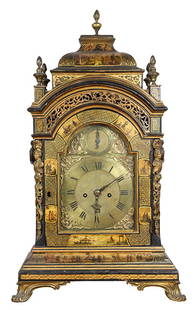
George III Bracket Clock, signed GEORGE CLERK (active ca.1780). London, last third s.XVIII. Cabinet
Similar Sale History
Recommended Items









Item Details
Description
George III Bracket Clock, signed GEORGE CLERK (active ca.1780). London, last third 18th century.
Cabinet case with gilt bronze applications.
Dial with Spanish strike-cancelling dial (for the Spanish market).
Calendar of the month.
Eight days winding machine, square plate, engraved on the back, hour chiming on a bell.
Measurements: 53 x 28 x 19 cm.
English table clock, bracket type, signed by the clockmaker George Clark. Its case is made of wood, decorated with gilded bronze applications with foliate and rocaille motifs worked in relief. It has an architectural structure, the flanks of which are decorated with stipes with anthropomorphic busts. The corners and the panels surrounding the dial are also made of finely worked bronze with vegetal fretwork in the form of tracery. The dial has Roman numerals (for the hours) and Arabic numerals (for the minutes) engraved in black on silver, with a gilded centre. The second dial functions as a chime and has an override dial. The Spanish names indicate that the British watch was intended for the Spanish market. The dome, which is stepped in the form of a talud, is topped with a handle and is decorated with bronze appliqués and fruit elements decorating the corners.
Bracket clocks of English origin are notable mainly for their mechanism, but also for their decoration. This type of clock originated in the 1960s, when the pendulum was applied to the clock, replacing the previous "foliot" regulator or balance. This change made it necessary to provide the mechanism with a case to protect it from shocks that could alter its movement. This was the origin of the watches known in England as brackets, i.e. portable watches. These were short cases which housed a mechanism held between two thick plates and contained, as the driving force for each train, a combination of a hub and a snail. These clocks were originally intended to be placed on a bracket, hence their English name. This bracket was a separate piece that was usually made at the same time, with decoration to match the clock. Later, however, the base and clock began to be made separately.
The English developed a watchmaking mechanics distinct from that of the rest of Europe, based on an industry of specialised workshops producing products of great technical perfection. The cases were made by cabinetmakers who enriched the watches, turning them into real jewels. For this reason, throughout the 18th century English clocks and watches were evidence of the stylistic evolution that developed in English cabinetmaking, starting with the William and Mary and Queen Anne models, passing through the Chippendale and Hepplewithe styles and finally returning to classicism with the Adam, the Sheraton and finally the Regency. As for the specific type of bracket clock, it maintained its elegant and stately appearance throughout the 18th century, and by the end of the century the cases would be larger and more monumental.
Cabinet case with gilt bronze applications.
Dial with Spanish strike-cancelling dial (for the Spanish market).
Calendar of the month.
Eight days winding machine, square plate, engraved on the back, hour chiming on a bell.
Measurements: 53 x 28 x 19 cm.
English table clock, bracket type, signed by the clockmaker George Clark. Its case is made of wood, decorated with gilded bronze applications with foliate and rocaille motifs worked in relief. It has an architectural structure, the flanks of which are decorated with stipes with anthropomorphic busts. The corners and the panels surrounding the dial are also made of finely worked bronze with vegetal fretwork in the form of tracery. The dial has Roman numerals (for the hours) and Arabic numerals (for the minutes) engraved in black on silver, with a gilded centre. The second dial functions as a chime and has an override dial. The Spanish names indicate that the British watch was intended for the Spanish market. The dome, which is stepped in the form of a talud, is topped with a handle and is decorated with bronze appliqués and fruit elements decorating the corners.
Bracket clocks of English origin are notable mainly for their mechanism, but also for their decoration. This type of clock originated in the 1960s, when the pendulum was applied to the clock, replacing the previous "foliot" regulator or balance. This change made it necessary to provide the mechanism with a case to protect it from shocks that could alter its movement. This was the origin of the watches known in England as brackets, i.e. portable watches. These were short cases which housed a mechanism held between two thick plates and contained, as the driving force for each train, a combination of a hub and a snail. These clocks were originally intended to be placed on a bracket, hence their English name. This bracket was a separate piece that was usually made at the same time, with decoration to match the clock. Later, however, the base and clock began to be made separately.
The English developed a watchmaking mechanics distinct from that of the rest of Europe, based on an industry of specialised workshops producing products of great technical perfection. The cases were made by cabinetmakers who enriched the watches, turning them into real jewels. For this reason, throughout the 18th century English clocks and watches were evidence of the stylistic evolution that developed in English cabinetmaking, starting with the William and Mary and Queen Anne models, passing through the Chippendale and Hepplewithe styles and finally returning to classicism with the Adam, the Sheraton and finally the Regency. As for the specific type of bracket clock, it maintained its elegant and stately appearance throughout the 18th century, and by the end of the century the cases would be larger and more monumental.
Buyer's Premium
- 23%
George III Bracket Clock, signed GEORGE CLERK (active ca.1780). London, last third s.XVIII. Cabinet
Estimate €2,000 - €2,500
2 bidders are watching this item.
Shipping & Pickup Options
Item located in Barcelona, -, esOffers In-House Shipping
Payment

Related Searches
TOP


















































